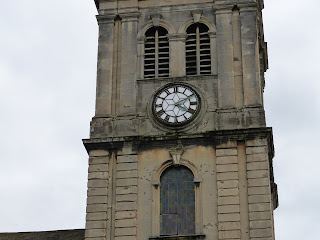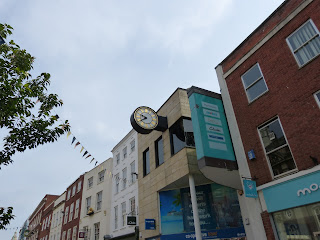Our first stop is All Saints church on Deansway - which is the first clock you come to if you walk into the city centre and you just happen to be staying at the Premier Inn at the County Cricket Ground.
Unfortunately for me, the church is not included in the "Worcester in 50 Buildings" book which I bought from the local Waterstones. So further research shows that the church has origins in the 12th century, and has included a re-build in 1739-42 and alterations by Aston Webb in 1889.
Our next clock is in Angel Place.
On one face you can clearly make out the words Midland Red Motor Services, which was a bus company operating under this name from 1905 to 1981. Clearly not related to the current occupiers of the building, Worcester Style Nails.
The High Street becomes The Cross, and reveals the clock at what is now a branch of Subway. I think that it is fair to guess that the clock was installed by a previous occupier of the site.
The clock face appears to have been rotated such that the 12 o'clock mark is at something like three minutes past. And this is not a happy clock, stuck at 12 o'clock and with a third of its glass missing on this side.
The Cross becomes Foregate Street, and at its junction with Sansome Street we have A-Plan Insurance.
This next beautiful brick clock tower is at the junction of Shrub Hill Road and Tolladine Road.
This is the Shrub Hill Engine Works, built in 1864 to construct locomotives. It was on a complex of railway lines including the main line through Worcester Shrub Hill station and a series of branches serving local industrial premises. Locomotive building at the site only lasted until 1870, with a total of 85 engines being constructed here.
The building is now in mixed industrial use.
We are back on the High Street now, trying to get a glimpse of this church clock which is now hemmed in by subsequent development. The roadworks also didn't help in being able to get a good photograph.
This is St Swithun's church, and we will get a better view of its other clock face later on.
There has been a church on this site since 1126. Of the current building, the tower dates from the 15th century, whilst the main body of the church was rebuilt in 1736.
It is now a Grade I listed building, but has been redundant since 1977. The interior is currently being restored to become an arts venue, which is due to open in late 2020.
Looking just along the road, there is another clock which marks the entrance to City Arcade.
Worcester Part 2 will be along shortly.
























































No comments:
Post a Comment